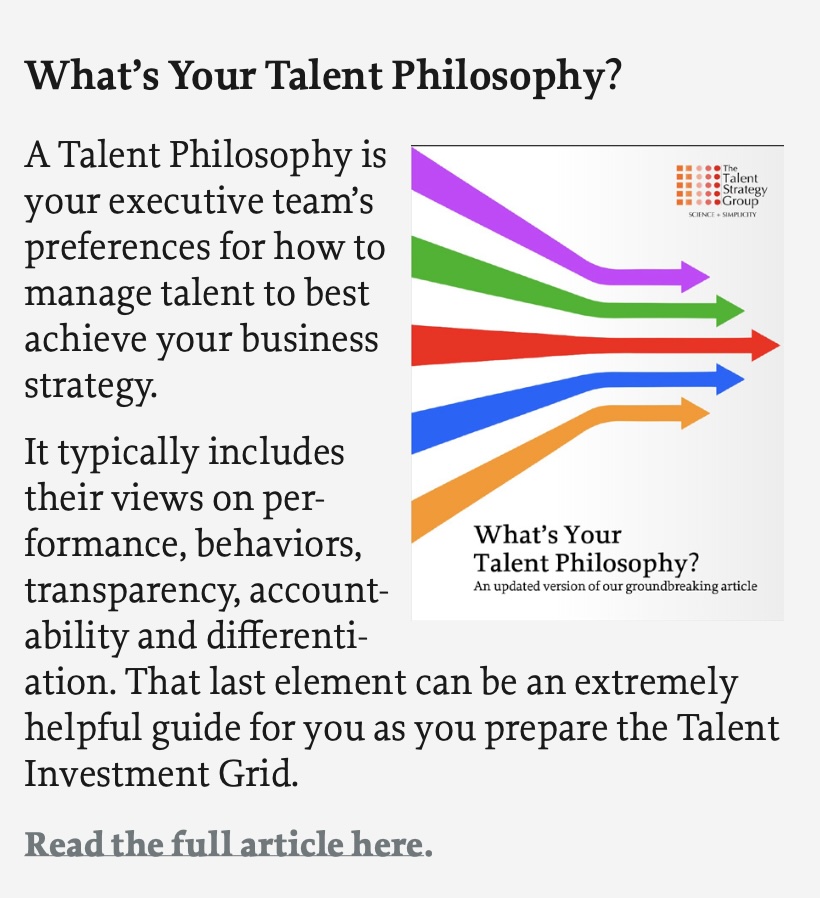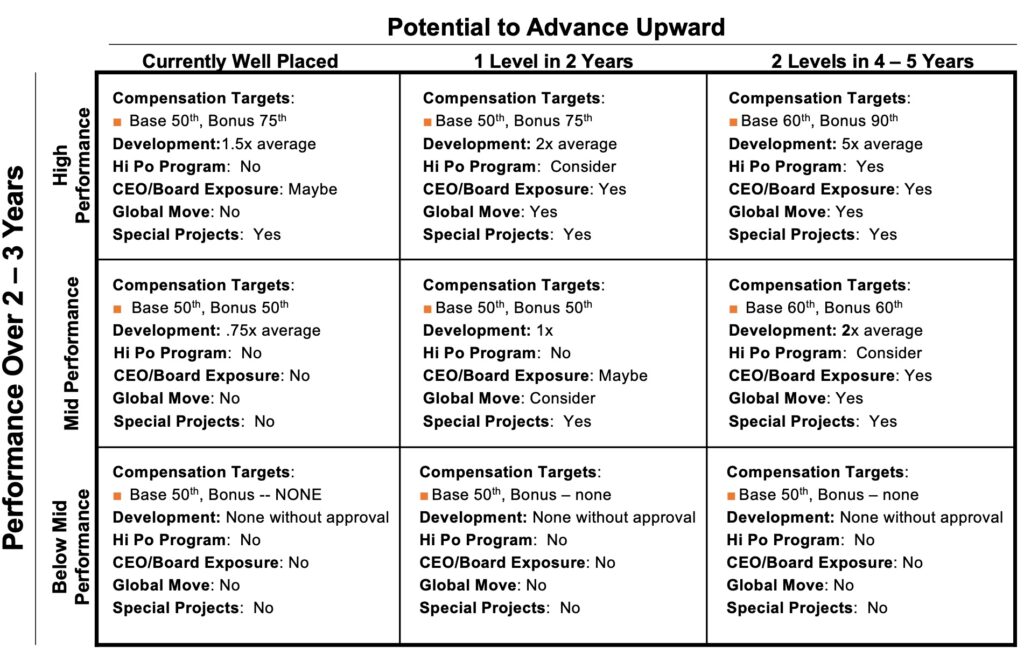A Prize in Every Box: How to Differentiate Your Talent Investment

Post content
It’s such a common scenario in talent reviews that we’ve even given it a name – upper right bias. That’s when managers place a strangely large percentage of their team in the high potential category, typically located in the upper right section of their potential tool.
That upper right bias could be due to managers confounding performance and potential or to inaccurately assessing team members. But when we privately ask managers why they overload that category, they tell us that it’s the only way to give their team members a “prize.”
If they want their team member to attend the executive education program – upper right box. Get invited to the CEO’s offsite – upper right box. Need to send a positive signal about retention – upper right box.
In many companies those managers are correct. It’s not that there aren’t other prizes to hand out, but their organization has never answered the question, “What’s our philosophy about how we differentiate rewards, recognition and development?” In other words, who gets which “prizes” and how many of them?
This is a core Talent Philosophy question – how do you want to differentiate how you invest in talent based on their performance and potential?
A Prize in Every Box
Getting to your company’s answer may be easier than you think. While ideally you would have a talent philosophy Differentiation plank to guide you, we can back into your point of view.
We call our approach having a “prize in every box” and it means identifying the differentiated investment you want to make in individuals who demonstrate different levels of performance and potential.
The “box” in this case is the box in a performance and potential matrix.
This is a surprisingly simple and powerful way to make your talent philosophy real, to drive transparency and to ensure consistent talent investments across your organization. Here’s how to make it work.
Let’s Start Here
The starting point in differentiation is to ensure that every employee has a great baseline experience that includes working for an organization they can be proud of, having a quality manager and the opportunity to grow and develop.
That baseline ensures that everyone is working in an environment that supports their performance and engagement. Everyone gets that prize.
Above that baseline, every employee should get an additional prize that’s based on their current and likely future contribution. This prize is their “fair deal” – the company’s additional investment to recognize their performance today and their future potential.
That prize includes their compensation and, more importantly, their fair share of the other development resources the company offers. This may include critical experiences, exposure to key leaders, internal and external development courses, highly-visible projects and high potential programs, among other investments.
The different prizes should clearly differentiate your investment in leaders, with higher performing and higher potential leaders receiving a disproportionately large prize. How disproportionate depends on your Talent Philosophy (see side bar).

We find a simple way to determine the prize for each box is to use our Talent Investment Grid (TIG). The TIG is a performance and potential grid that details how you plan to invest in leaders in each box.
It’s a simple tool but it requires that you have either an executive Talent Philosophy or a clear understanding of how you want to differentiate people investments. If you don’t use a 9-box grid, substitute the tool you use. It should work the same way.
With that guidance in hand, gather a small number of senior HR leaders for a 90 minute, highly-focused exercise to fill in your TIG.
Figure 1: Talent Investment Grid (TIG) Example

The process is as simple as:
Step 1: List the meaningful development and reward elements that an employee can receive.
That includes the items listed above and any other performance-related benefit. Exclude any reward based on tenure and any benefits available to everyone.
For example, quality time with your CEO is a limited resource that not every employee gets. Access to a discounted gym membership is a benefit that every employee is eligible to receive.
Step 2: Identify how you want to allocate each element in each box.
Once you have your long list, classify each element by Yes, No, or Preferred Access for each box on the grid. The latter category means that they’re the first invited to certain development or exposure opportunities.
List compensation by vehicle – base, bonus and LTI. We’re fans of aligning LTI investment to an individual’s potential (but that’s our talent philosophy, not necessarily yours).
Pay Special Attention to These Boxes
High Performance: If you’ve attended our Talent Management Institute or been our client, you’ve likely heard our mantra that “We love high performers!”
That mantra originally spurred the Talent Investment Grid as we saw organizations not differentiate how they managed this talent segment. In a typical 9-box grid, this is the upper-left box.
Remembering that “high performer” means consistently differentiated performance over multiple years, high performers should be sent a clear signal that they are highly valued.
This suggests that they receive an investment that is noticeably different than typical performers – not just in the bonus they’ve earned, but in their professional development, their exposure to the company, their option to lead high visibility projects and more.
They need to understand that your company wants them “here, productive and happy” for many years to come. They also need to understand that this investment is about performance, not about potential.
High Potential: This may seem like the easiest box to load up with “goodies,” but remember that all those goodies, from CEO exposure to executive education dollars, exist in a limited quantity.
In many organizations, there are more individuals listed in this box than likely belong there if accurately assessed. If that’s true in your organization, it means that your “fake” high po’s are limiting what your “true” high po’s can get.
This can be a great forcing mechanism in your talent review discussion however. If your TIG says that there are five spots available in the high po acceleration program, but seven high po’s are listed in your performance and potential grid, let’s have the discussion. Of the seven, who are the five best high po’s we have?
Your high potential investment should be meaningful to those who receive it. They should understand that this is the organization’s clear signal of confidence in them as a future executive. It should be clearly different from the high performer investment.
Low Performer: The TIG gives you a great chance to send a clear message to those who consistently under-perform in your organization. We know they still exist because you tell us they do, and we even wrote a case study about them (“What Should We Do About Hal ?”).
Tell them and their managers that they’ll get a very small, or no, share of many investments unless their performance improves. They may have never heard this direct of a message before. Now is the ideal time to share it with them.
Step 3: Use the TIG to Drive Consistent Investments
After you’ve developed the TIG, educate managers about the tool and how to use it. They should understand that the TIG provides guidelines, not rules, but that similarly placed people should have relatively similar investments.
Ask managers to use the grid as a guide when considering assignments, experiences, projects, bonuses, etc. after the next talent review.
A year after you’ve implemented the TIG, audit a layer of your organization to see how closely the actual investments are to what should have been made.
Using the TIG to Drive Transparency
This next step is optional but, if you want to be transparent, strongly recommended. Communicate the TIG to your employees. Transparency about the prize in each box means that they should understand their prize and the other possible prizes as well.
This may lead to a few uncomfortable conversations but also many more productive ones. Employees will know their prize and will understand what to do in order to get a different prize (increase their performance, demonstrate more potential, or both).
We also understand that not every employee will appreciate learning about their prize. We’re certain that nearly all high potential and high performing leaders will appreciate your honesty.
For everyone else, you’re treating them like adults who are capable of either accepting that prize or asking what’s required to win a different prize.
Transparency isn’t easy but, if we shift our mindset away from “high potential” being the only prize, it makes it far easier to be honest with everyone about where they stand.
Let’s Differentiate!
How you differentiate your talent investments sends a clear message about what you value and why. It makes your workplace more fair because the “rules” are more clear. It ensures that you’re getting the expected return on your talent investment.
The process to get there is likely easier than you expected. We encourage you to make time in the next 30 days to identify all your company’s prizes and determine your philosophy around which prizes belong in which boxes.